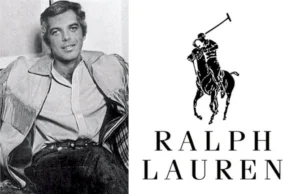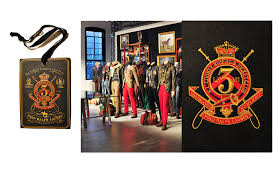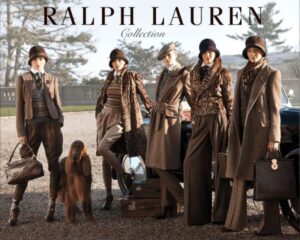Ralph Lauren logo and its history!

Ralph Lauren Logo and Its History
The Ralph Lauren logo is one of the most recognizable symbols in fashion history. Depicting a polo player mid-swing on horseback, it represents much more than a brand—it stands as a symbol of luxury, class, and timeless American elegance. From its humble beginnings in the 1960s to becoming a global powerhouse in fashion and lifestyle, Ralph Lauren has consistently used its logo to project an image of refined aspiration.
 Origins of the Brand
Origins of the Brand
The Ralph Lauren Corporation was founded in 1967 by Ralph Lifshitz, who later changed his last name to Lauren. A Bronx-born son of Jewish immigrants, Ralph Lauren began his career in fashion by designing neckties. With a clear vision and an eye for design, he soon launched a full line of menswear under the brand name Polo, which would eventually become the foundation of his empire.
At the time, Lauren’s designs stood out for their European flair mixed with American spirit—think wide ties, tweeds, and sporty elements combined with Ivy League tailoring. It was during this early stage of brand development that the idea for a logo to match this distinct identity came into play.
Introduction of the Polo Player Logo
The now-famous Polo Player logo first appeared in 1971, originally on the cuffs of women’s shirts. It quickly became a staple, moving into men’s lines and spreading across various clothing and accessory items. The choice of a polo player was intentional and deeply symbolic.
Polo, as a sport, has long been associated with the British aristocracy and American upper class. It’s exclusive, elegant, and steeped in tradition—all the qualities Ralph Lauren wanted his brand to embody. The image of a polo player in action perfectly captured the brand’s aspirational ethos and subtly suggested that wearing Ralph Lauren was not just about clothes—it was about lifestyle.
Design and Symbolism
The Ralph Lauren logo features a silhouette of a polo player on a horse, mid-swing with a raised mallet. It’s typically embroidered or printed in a solid, dark color, often navy blue or black, against a contrasting background. The design is relatively simple, but its elegance lies in its subtlety.
Beyond just fashion, the logo communicates a story: one of refinement, competitive spirit, and tradition. It has come to symbolize everything the brand stands for—classic American style, elevated living, and enduring quality.
The fact that the logo has barely changed in over 50 years speaks volumes about its effectiveness. While other brands constantly rebrand or modernize their logos, Ralph Lauren has stayed consistent, banking on the strength and clarity of its original vision.
Evolution of the Brand and the Logo’s Role
Throughout the decades, Ralph Lauren expanded his offerings from ties and polos to full fashion lines for men, women, and children. Eventually, the brand grew into a lifestyle powerhouse, including home décor, fragrances, accessories, and even restaurants and cafes. Through all of this, the polo player remained a constant.
The logo wasn’t just reserved for clothing—it was stitched onto towels, printed on perfume bottles, and etched into dinnerware. It became a visual signature, instantly conveying quality and luxury, no matter the product category.
In addition to its use in various product lines, Ralph Lauren has also created sub-brands such as Polo Ralph Lauren, RRL, Lauren Ralph Lauren, and Polo Sport, each targeting different market segments but often carrying some form of the iconic logo.
Cultural Impact and Recognition
The Ralph Lauren logo has transcended fashion to become a cultural icon. In the 1990s, it gained huge popularity among diverse audiences, including the hip-hop community, which embraced the Polo aesthetic as a status symbol. Groups like the “Lo Lifes” from Brooklyn made Polo Ralph Lauren a central part of their identity, flipping its upper-crust image into a bold streetwear statement.
This crossover appeal further cemented the Ralph Lauren logo as not only a symbol of wealth and tradition but also one of cultural versatility. Few logos have managed to retain their prestige while being embraced across such diverse demographics.
 Legacy and Timelessness
Legacy and Timelessness
What makes the Ralph Lauren logo truly special is its timelessness. In a world where trends shift rapidly, the brand has maintained a consistent aesthetic, anchored by the unwavering presence of the polo player. That consistency has earned Ralph Lauren a place among fashion’s most enduring names.
The brand’s commitment to quality, storytelling, and lifestyle branding ensures that the logo will continue to carry weight for generations. Whether it’s seen on a classic cotton polo shirt or a luxury cashmere throw, the Ralph Lauren emblem immediately evokes elegance, authenticity, and timeless American style.
Conclusion
The Ralph Lauren logo is far more than a visual identifier—it’s a narrative. It tells a story of ambition, class, and aspiration. It taps into the romantic ideal of a sophisticated, polished lifestyle and invites customers to partake in that dream. Whether worn in the Hamptons, the streets of New York, or the clubs of Tokyo, the Ralph Lauren polo player is instantly recognizable and universally respected.
Over 50 years after its debut, the logo remains a powerful example of branding done right: consistent, meaningful, and emotionally resonant. It’s a testament to Ralph Lauren’s genius—not just as a designer, but as a visionary.















